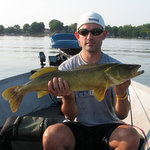Environmental Issues in Minnesota
 Sulfide mining produces toxic waste that could irreversibly damage Minnesota’s fragile lakes, rivers and natural resources.
Sulfide mining produces toxic waste that could irreversibly damage Minnesota’s fragile lakes, rivers and natural resources.
This is not our grandparents’ iron mining — sulfide mining has never been done in Minnesota. While iron mines have significant environmental challenges of their own, the sulfuric acid that is produced with sulfide mining makes it particularly difficult to avoid polluting nearby lakes, streams and ground water.
Acid Mine Drainage
When water and air mix with the waste from iron mining, rust is produced. But when the same process happens with sulfide mining, sulfuric acid is created. When this acid dissolves rock and leaches out toxic heavy metals, the substance is commonly called “Acid Mine Drainage.”
When water and air mix with iron mining waste, you get rust. With sulfide mining, sulfuric acid is produced.
 Acid Mine Drainage has devastated water bodies in many states where this type of mining has occurred. It kills fish, wildlife and plants, leaving lakes, rivers and streams devoid of most living creatures.
Acid Mine Drainage has devastated water bodies in many states where this type of mining has occurred. It kills fish, wildlife and plants, leaving lakes, rivers and streams devoid of most living creatures.
Effects on people, water and wildlife
Humans
Mining by-products such as arsenic, manganese and thallium, have been shown in high levels to increase the risk of cancer and other illnesses in humans. Because mining takes place below the water table, it’s easy for contamination to leach out of the mine into groundwater, threatening drinking water supplies and health. More about risks to human health…
Fish
Fishing is a popular pastime in Minnesota, and an important economic engine in the region where sulfide mining is proposed. Fish that come into contact with Acid Mine Drainage can die from the toxic chemicals and acidic water, and the pollution can also destroy their food sources and habitat.
 Birds
Birds
Unlike with most iron mining, sulfide mining pit-lakes can be highly contaminated water bodies, with acid and metal leaching occurring along the pit walls. Unsuspecting migratory waterfowl and other wildlife may use the pit-lakes as resting places or water sources, and become poisoned.
Wetlands
The destruction of more than 1, 000 acres of wetlands at the PolyMet mine site would be the single largest loss of wetlands ever permitted in Minnesota. Wetlands are destroyed by being excavated for mining, and also when mining pulls water from an area, drying them up. Additionally, a loophole in the Clean Water Act allows mining companies to dump waste into wetlands.
America’s biggest polluter
In 2010, the metal mining industry was responsible for 41 percent of all toxins released into the environment.
The EPA produces an annual “Toxic Release Inventory” (TRI) that provides the public with information about toxic releases in and around their communities. The 2011 TRI data show that, as with every year since 1997 when the metal mining industry was required to report, this industry releases the largest amount of toxic materials, accounting for 41 percent of all toxics reported.
A history of contamination
Sulfide mining has a near-perfect track record of creating pollution. Mining companies are unable to point to a sulfide mine that has ever been developed, operated and closed without producing polluted drainage from its operations.
Mining companies are unable to point to a sulfide mine that has not polluted.
Not only do these mines consistently pollute, but studies show the companies and state agencies reviewing mine plans predict no pollution will occur, when in fact, it always does. In addition, efforts taken to remedy pollution problems fail 64 percent of the time.









